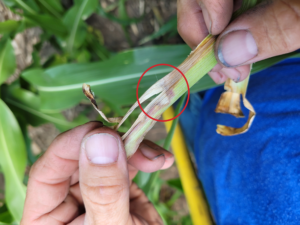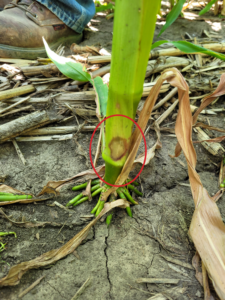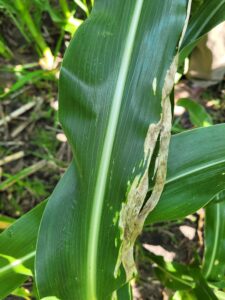Goss’s Wilt Alert! Check Your Fields—Now

Goss’s wilt is exploding in fields across the Corn Belt right now. If you haven’t been scouting your cornfields for Goss’s Wilt, get out there now.
“I’ve never seen Goss’s Wilt this bad this early in the growing season,” said Dennis Klockenga, a crops specialist with ProfitProAG. “Goss’s Wilt is measured on a 9-point scale, and I’ve seen corn rated as a 4 where the Goss’s Wilt is disastrous.”
Why? “The new strain of Goss’s Wilt is more virulent than previous strains,” Klockenga added.
Goss’s Wilt primarily infects leaves that have been wounded, such as by hail, sand-blasting, rain, wind, and strong storms. The disease spreads in the plant following leaf infection, and can spread from plant to plant. Disease development is favored by warm (greater than 80 degrees Fahrenheit) conditions.

Crops in many areas are suffering from drought stress this summer. This stress makes them more susceptible to disease, including Goss’s Wilt, which is caused by a bacterial pathogen, Klockenga said.
How do you know if you have Goss’s Wilt? Right now, I’m primarily seeing it on the lower leaves that are drying up and falling off. When you peel those leaves off the stalk, where they attach to the stalk, you’ll see brownish, white lesions (see pictures.) As it progresses, the leaves will have elongated tan lesions with irregular margins extending parallel to the veins. Large sections of leaf area can be affected. Dark, water-soaked spots (‘freckles’) develop in the lesions. Shiny patches of dried bacterial ooze that appear similar to dry varnish are often present on the lesions.
Corn infected with Goss’s Wilt shows poor nutrition of the kernels. This corn is not good to use for feed or seed corn, since it doesn’t contain the nutrient levels, it should. Infected plants can also die prematurely, which translates to lower yields and lower nutrient density.
Interaction of Goss’s Wilt & Tar Spot
Goss’s Wilt shuts down the plant’s immune system and allows Tar Spot to attack when the plant is the most susceptible. Goss’s Wilt affects the nutrient and water flow and while the plant is suffering, it allows disease such as Tar Spot to infect it. Both pathogens also readily survive in infected residue on the soil surface, serving as the primary inoculant source for future crops.

Feed your crops right
Spraying crop protection products won’t solve the tar spot or Goss’s wilt problems.
Klockenga recommends Bio Empruv Gen 2. This foliar feeding system is a blend of biological stimulants, natural fermentation extracts, natural surfactants and microbial metabolites. Bio Empruv Gen 2 stimulates the plant’s defense mechanism and improves resistance against many environmental and physiological disorders, including Goss’s Wilt and Tar Spot.
This product technology applied at our current stage of corn development will boost your crop’s immune system and yield potential. This approach could mean extra bushels on your bottom line. You already have invested financially in putting the crop in the ground, why not protect and leverage that investment.
For more information on Bio Empruv Gen 2 from ProfitProAG, contact Klockenga at 320-333-1608
Office – 507-373-2550 / info@profitproag.com
Dr. Jim Ladlie – 507-383-1325 / jladlie@profitproag.com
Dennis Klockenga – 320-333-1608 / dklockenga@profitproag.com
Tony Ritten – 715-501-0190 / tritten@profitproag.com
John Pernat – 920-285-2400 / johndpernat@gmail.com
